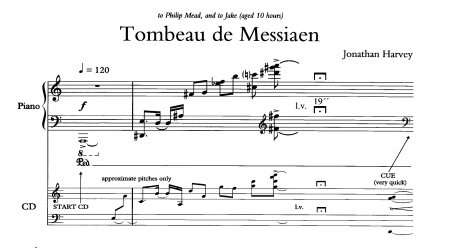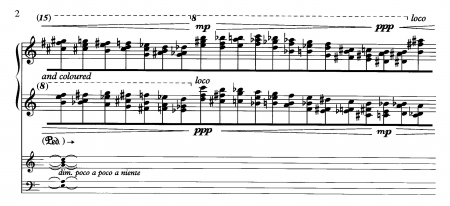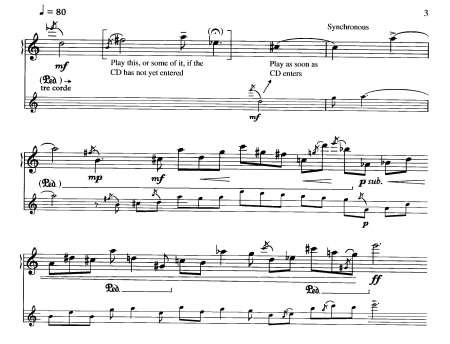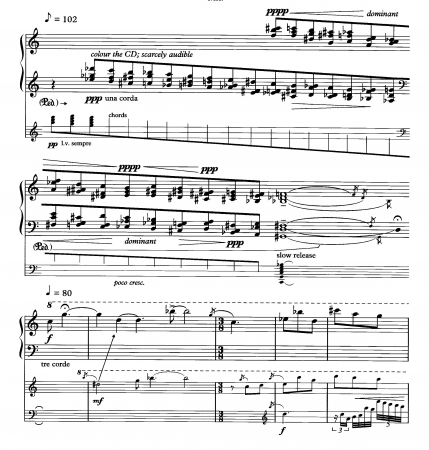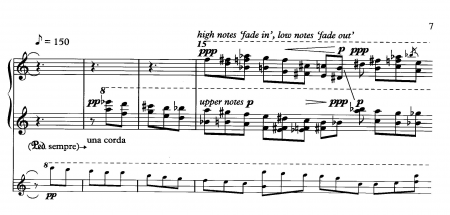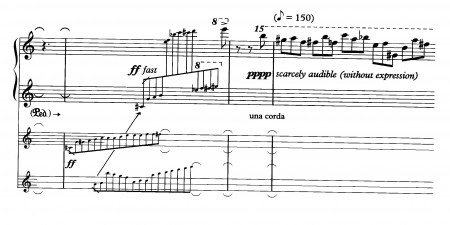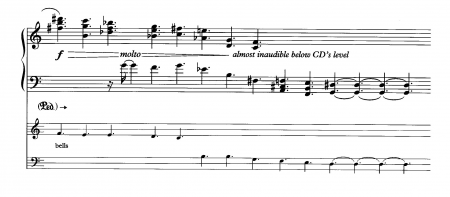In and out of exactitude: jonathan harvey’s Tombeau de Messiaen
Philip Mead décembre 2013
décembre 2013DOI : https://dx.doi.org/10.56698/rfim.268
Résumés
Résumé
Philip Mead a commandé et créé Tombeau de Messiaen en 1994. Cette pièce est de nos jours reconnue comme un classique de la musique mixte, étant jouée par de nombreux pianistes dans le monde entier. Cet article explore la raison d’être de l’œuvre, sa relation à la musique pour piano de Messiaen, la nature de l’écriture pianistique, la nature des sons électroniques et comment ils se rapportent aux sons instrumentaux, sa relation avec les autres œuvres de Jonathan Harvey, et tout ce que j’ai appris de l’œuvre en étudiant ses nombreux croquis, et en travaillant en étroite collaboration avec le compositeur en vue de la création. Philippe Mead revient sur ce que déclarait Harvey : la clé de la compréhension de l’œuvre réside dans un déplacement “dans et hors de l’exactitude”.
Abstract
Philip Mead commissioned and first performed Tombeau de Messiaen in 1994. It has since come to be recognised as a classic example of musique mixte, being performed by many pianists around the world. This paper explores the work’s raison d’être; its relationship to the piano music of Messiaen, the nature of the piano writing, the nature of the electronic sounds and how they relate one to another; its relationship to his other works; and the many fascinating insights I learned about the work by studying his many sketches, and working closely with the composer in preparation for its first performance. Above all an explanation of what Harvey meant when he said the key to understanding the work was that it moved ‘in and out of exactitude’1
Index
Index de mots-clés : musiques mixtes, Jonathan Harvey, musique pour piano et électronique.Index by keyword : music for piano and electronics, Jonathan Havey.
Texte intégral
1In 1985 I had begun to perform Jonathan Harvey’s then sole piano piece Four Images After Yeats. I worked with the composer on it and gave it a number of performances – according to the composer’s note on the CD recording more than any other pianist.2 Harvey also knew at first hand my performances with electronics. Even so my ‘cold call’ to see whether he would like to write a piece for piano and electronics was a shot in the dark. He himself was a cellist and seemed to have a preference for composing for strings and/or voice. It took a mere 10 days however between this phone call and his reply saying that he would like to write a piece; that it would be an elegy to Messiaen; and that he had the outline of the work already in his head. He had been searching for a way to express his deep feelings about the loss of this great composer who had died in 1992, but until my phone call had been unsure how to do it.
2The title he gave the work, which was to be Tombeau de Messiaen, literally – ‘at the tomb of…’, is in the tradition of memorial pieces going back as far as Froberger’s Tombeau fait à Paris sur la mort de Monsieur Blancheroche – a Paris lutenist. (A well known twentieth century example is Ravel’s Tombeau de Couperin)
3Harvey’s titles are usually very meaningful and can often involve the juxtaposition of opposites. (We can cite Madonna of Winter and Spring, Lightness and Weight, Death of Light, Light of Death etc.) Although the title of this piece does not involve so obviously the use of opposites, there is a double meaning in this context for the word ‘tombeau’. ‘Tombeau’ follows the venerable French tradition, but is also used in the sense of its close phonetic neighbour – the verb ‘tomber’ – to fall. We find that much of the composition deals with gestures that fall, right through to the very final page with its almost Lisztian bravura.
4Harvey’s programme note gives us a good insight into the nature of the piece;
This work is a modest offering in response to the death of a great musical and spiritual presence. Messiaen was a proto spectralist, that is to say, he was fascinated by the colours of the harmonic series and its distortions, and found therein a prismatic play of light. The tape part of my work is composed of piano sounds entirely tuned to the harmonic series – twelve of them, one for each class of pitch. The ‘tempered’ piano sounds joins and distorts these series, never entirely belonging, never entirely separate. The associations with the word tombeau (tomber) suggested a falling motive for the work, at the end the piano extends the motive, flinging itself into a downwards vortex to the abyss.3
5We know from Yvonne Loriod that Messiaen himself suffered greatly in the last months of his life (Hill, 1995, p. 302). Ideas of suffering are fundamental to Harvey’s compositional process:
People ask why; why more suffering? They believe that the depiction of evil itself causes suffering, and object to this. But the answer is that precisely the opposite is true: suffering encountered in art or ritual is healing. If we give ourselves to the experience of art, fully and fearlessly, we are journeying inward to our truth, from where we will find our new world. (Harvey, 1999, p. 74)
6The work was obviously part of the healing process for Harvey himself to channel his feelings of loss at the death of a great composer. On the other hand Harvey’s ‘new world’ was undoubtedly that of spectralism;
spectralism is a moment of fundamental shift after which thinking about music can never be quite the same again. Spectral music is allied to electronic music: together they have achieved a re-birth of perception. The one would scarcely have developed without the other. Electronic music is a well documented technological breakthrough, spectralism in its simplest form as colour-thinking, is a spiritual breakthrough. (Harvey, 2001, p. 11-14)
7Now let us consider the work in more detail:
8On a macro level the structure of the work is achieved by a series of gradually quickening pedal points with both live instrument and electronic sounds. For instance, the first pedal point (A) lasts for the first four pages of printed score while on the penultimate page they change so fast as to be beyond human perception. When the pedal points reach a moderate speed they are transformed into bell sounds and create an aural link with the opening falling phrase on the piano – a powerful example of the composer’s love of transformation and ambiguity.
9The piano writing falls mainly into two categories; the falling chords near the opening and monodic lines. The electronic part consists of some gong sounds but mainly piano sounds tuned to twelve harmonic series using the Yamaha SY77 harmonic series micro tuning.4
10The opening low note A is as already mentioned the first pedal point, and this is followed by an upward motive on piano and electronics.5 The succeeding pause is deliberately longer than would normally be expected (19secs) to represent the shock and stillness of life being cut off by death. Harvey has acknowledged the influence of Rudolf Steiner in his thinking. Transcendent experiences have been very meaningful, particularly the value of silence and long held notes:
In particular, silence began to become more prominent in my music, and near-silence, and also long sounds which were static, and rather empty – the concept of emptiness gain. (Whittall, 1999, p. 15)
CD example 1, (0 – 40”)
>> listen / écouter
Score: page 1, 1st system
11One of the most revealing statements that the composer said about the work is that it moves ‘in and out of exactitude’ and does so on both a micro and a macro level. The composer has confirmed to me6 that this idea is omnipresent in the two tuning systems discussed below, the slowly moving pedal points already mentioned and in the falling piano phrase found at the bottom of page 1:
CD example 2, (41” – 1’30”)
>> listen / écouter
Score: page 2, 1st system
12The two hands of these descending chords have ‘cross over dynamics’ which the composer wanted emphasised. These chords, while clear at the top end of the piano gradually descend into obscurity because of the continued use of the sustaining pedal. Both the cross over dynamics and the gradual obscuring of the chords by the pedal are examples of ‘in and out of exactitude’.
13These chords have an obvious kinship to the piano writing of Messiaen though Harvey does not quote or use specific chords from that composer.
14This is followed by the second type of piano writing – monody. The monodic passages play on two tuning systems, the tempered scale of the piano and the pure tuning of the electronic part. The composer has explained:
Instead of the pianos on tape playing the normal tempered tuning, they play only in natural harmonic series. And these micro-intervallic harmonic series are played at the same volume as the normally tuned live piano, so the live piano seems to belong to the harmonic series and it becomes part of a unified structure. But then it also has notes every now and again which are out of tune, or more often than that, and it completely leaves the membership of the harmonic series, so it becomes something in dialectic, in argument with the fused nature of the harmonic series. (Whittall, 1999, p. 28)
15In the two tuning systems we have the crucial raison d’être of the work and its main claim to be ‘in and out of exactitude’. The electronic sounds are tuned to the natural harmonic series involving perfect whole number ratios, 1:2:3:4:5:6 etc. while the piano is tuned to ‘equal temperament’. On the score the notes are often the same, yet in performance there are varying degrees of microtonal differences.
The tape consists of 12 pianos all tuned in harmonic series, each on one of the twelve pitch-classes. The solo piano itself remains normally tuned, but when the balance is good (so that taped and live pianos are indistinguishable) the piano has the role of providing the grit, the resistance to the spectra without seeming to be altogether outside them, partly because it often plays the same or nearly the same, spectral pitches. The fact of partly not fitting makes the discourse interesting for me, as it changes constantly from spectral fusion to microtonal polyphony and back. Either of these principles without the other seems a less rich and attractive option for composition as I see it at this point in time. (Harvey, 2001, p. 11-14)
16In his article “The Mirror of Ambiguity” (Emmerson, 1986, p. 179), the composer has explained this phenomenon in a different context ten years before this piece was composed.
The ‘timbral experience’ is fundamentally one of shifting identities. The fusion of the two spectra into one magical spectrum does not mean we lose sight of the separate instruments, but that there exists a particularly intriguing combination of spectra as well as the original ones:
CD example 3 (1’31” – 2’18”)
>> listen / écouter
Score: page 3, 1st 2nd 3rd systems
17We next find a section that seems to ‘develop’ some of the ideas already presented, starting with the descending chords but this time both on piano and electronics thus giving an out of tune feel due to the different tuning systems. This is followed by references to the monodic section:
CD example 4 (2’19” – 3’ 30”)
>> listen / écouter
Score: page 4, 2nd 3rd 4th systems
18The falling chords are now developed extensively in what Harvey called a ‘waterfall’7. Pianistically the waves of chords appear approximately every eight chords shadowed by a monodic line on electronics which begins the contrapuntal texture.
CD example 5 (3’31” – 4’55’)
>> listen / écouter
Score: page 7, 1st system
19The next section shows an interesting example of an afterthought by the composer. The series of upward arpeggios were originally left hanging echoing the original upward motive at the opening, but the composer felt too little was happening, so the long held sounds now have a very quiet interweave of melody from the piano in its topmost register.
CD example 6 (4’56” – 6’21”)
>> listen / écouter
Score: page 10, 3rd system
20At the last section we have the meeting of two salient features of the work. The section appears to be initiated by gong (bell) sounds, but these are also in reality the pedal notes now at an approximate speed of one per second.
CD example 7 (6’21” – 6’50”)
>> listen / écouter
Score: page 13, 3rd system
21As they speed up still further the relationship to the original piano motive becomes obvious. They then speed up to the limits of human perception and beyond and at this point the pianist is asked to improvise on certain given figures. Harvey has said that he does not generally use improvisation,8 but at this stage in this work it becomes a pragmatic solution to the exponential increase of speed of the piano with electronic parts ready for the final descent, and also allows the pianist freedom to become more manic than would perhaps otherwise be the case. The juxtaposition of apparent chaos to the stark major chord near the end is the most extreme example for me of ‘in and out of exactitude’. The fact that this chord is of F sharp major – the main key of Messiaen’s Vingt Regards sur l’enfant Jesus is no accident, but an affirmation of the title.
CD example 8 (6’50” – 8’5”)
>> listen / écouter
Score: page 17, 3rd system
22Arnold Whittall (1999, p. 74) has written that the final musical descent of this piece represents the ‘inescapable reality of death’. I have never been happy with this interpretation and asked the composer whether, if the opening rising motive represents life being cut off by death, it is not therefore reasonable to suppose that the final falling motive is purgatorial – leading to resurrection? He would give no direct reply saying that if he did he feels it would limit the piece, but said that the idea was a ‘sympathetic’ one.9 This idea may also be reinforced by the fact that the piece is not only dedicated to me but also to Jake Harvey Turner, the composer’s grandson, who was born ten hours before Tombeau de Messiaen was finished.
CD example 8 (to end)
Score: page 17, 6th system
23*
Bibliographie
Bibliography
Emmerson Simon (Ed.) (1986), The Language of Electroacoustic Music, London: Macmillan Press.
Harvey Jonathan (1986), “The Mirror of Ambiguity”, in The Language of Electroacoustic Music,Simon Emmerson (Ed.), London: Macmillan.
Harvey Jonathan (1999), Music and Inspiration, London, New York: Faber and Faber.
Harvey Jonathan (2001), “Spectralism”, Contemporary Music Revue, vol. 19, part 3, New York: Harwood Academic Publishers.
Hill Peter (Ed.) (1995), The Messiaen Companion, London: Faber and Faber.
Whittall Arnold (1999) Jonathan Harvey, London: Faber and Faber.
Music Score
Harvey Jonathan (1996), Tombeau de Messiaen, London: Faber Music, reproduced by permission of Faber Music.
Discography
Harvey Jonathan (1999), Tombeau de Messiaen, on Sargasso SCD 28029.
Annexes
Notes
1 Email from the composer to the author, March 2006.
2 CD liner notes Jonathan Harvey Sargasso 1999 (SCD 28029).
3 Ibid.
4 Email from composer to the author March 2006. The electronic part was recorded in the composer’s own studio.
5 Note that Harvey here and elsewhere always gives the pianist a cue to synchronization by introducing the electronic sounds first. Where the piano begins there is usually a pianistic fermata to facilitate synchronization.
6 Email from the composer to the author, March 2006
7 During rehearsals for the premiere 1994.
8 Talk given by the composer, King’s Hall Place, 5th October 2009.
9 Email from the composer to the author, March 2006.

